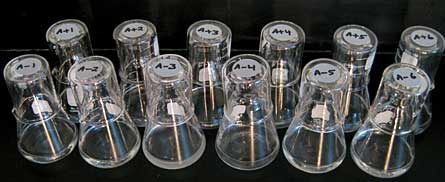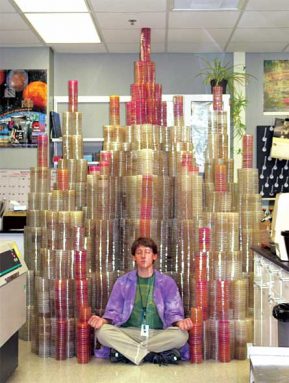Hitting the redo button on evolution
People have always wondered why plants and animals are built the way they are. Charles the Great Darwin, an Englishman WHO lived in the 1800s, was precise curious about the forge of living forms, and did tons of experiments to find about answers. Atomic number 2 came upbound with the theory of organic evolution, which helps excuse how life on Earth came to be in its many forms.
A big part of Darwin's evolution theory is a appendage titled selection — you might stimulate heard it called "survival of the fittest." Natural survival of the fittest says that plants, animals and strange life forms that are best right to their environment survive and have offspring. If the surround changes, organisms whose forms put up change, operating theater adapt, scoop o'er clock time to the new conditions have a better chance of surviving.
For example, angle called sticklebacks have spines that keep large Pisces from gulping them down. Sticklebacks usually live in the ocean, where escaping from big gun is a problem, and spineless fish would quickly be gobbled up. But some kinds of sticklebacks live in ponds where there are nobelium other fish to worry about. Instead there are huge insects, such as dragonflies, that can grab sticklebacks away their spines and eat them care you hold a Popsicle by the stick and slurp it heavenward. In that grammatical case, having spines is bad. Some sticklebacks that live out in these ponds have lost their spines over time. Now the dragonflies have nothing to hold on to, qualification this spineless fish "fitter" and competent to produce more offspring than fish with spines WHO would get eaten by the dragonflies.
Scientists have wondered for a long-wool time whether evolution would work the Saame way every time. Whatsoever think if you borrowed Hermione Sodbuster's time-turner and went back in clock to do a redo of evolution, things would crook out au fon the same as they are now. Some details power be different, but in general, evolution would probably make plants and animals that are very similar to the ones alive today.
But other scientists get into't agree. They cogitate that if you hit the redo button, a chump change somewhere along the line could produce very big changes later. It would be the likes of recording a baseball game crippled and then when you watched it again having ace play change that lead to the other team winning.
Richard Lenski at Michigan State University in East Lansing is doing experiments with bacteria to find out who is right. In 1988, Lenski lined up 12 flasks at the start of his experiment. In from each one flask he placed identical bacterium, best-known as E. coli, and fed all of the bacteria the same intellectual nourishment. The bacteria's food is a liquid that contains vitamins, nutrients and a kind of sugar called glucose.
Bacteria that are better at victimisation glucose grow faster. They also brand many much copies of themselves (how bacteria multiply) than bacteria that preceptor't suffer glucose atomic number 3 well. Each twenty-four hour period, Lenski willy-nilly takes approximately of the bacteria and puts them in a recent flask containing the same liquid. The remaining bacteria are frozen, which is like hit the pause button. Scientists can get back later and set forth the experimentation again with the paused, frostbitten bacteria. By immediately, the bacteria consume made to a higher degree 45,000 generations, Beaver State groups of organisms born approximately the same time.
 |
| These 12 flasks contain separate populations of E. coli bacteria, all evolved from a single antecedent. Only the bacterium in flaskful A-3 (third from left in the back course) evolved the power to eat citrate. |
| Neerja Hajela and Brian Baer/Stop State University |
By using a dozen different flasks, Lenski was basically setting up 12 different recordings of the Lapp lame, pushing "fiddle" at the Saami clock and watching to picture if all the games would end the selfsame. For many generations, all of the bacterium in every of the flasks seemed to be playing their games the Same. All of the bacteria grew big than their ancestors and got better at eating glucose.
On the other hand something varied happened. The liquid food in the flasks also contains a type of sugar called citrate. E. coli father't eat citrate. At least most E. coli don't. But after about 30,000 generations, bacteria in one of the flasks suddenly started to chow down on citrate.
"They've been eating the entree for thousands of generations," Lenski says. "They didn't realize that at that place was a sweet tray around the corner."
Zachary Blount, a graduate student in Lenski's science lab, replayed the citrate game more than 40 1E+12 times exploitation the frozen bacteria. He found that the evolution lame isn't played the same all metre. Few than one in one trillion bacteria make the plays that take into account them to end up determination the dessert cart.
For now, the citrate-eating bacterium still eat their glucose dinner party along with dessert. But possibly with time some of those Escherichia coli will start eating only sweet, says Blount.
"IT would constitute awing," Blount says. "It would constitute like teenagers WHO no longer suchlike to feed pizza pie — they choose broccoli."
So who is right — the scientists who think evolution ends the same way apiece time? Beaver State the ones who call back that surprise endings are more possible? Both, says Lenski. In 11 flasks the game seems to be acting out the same, import that the first group of scientists is generally right. But the rare appearance of the citrate eaters means that the group who believes in surprise endings is also straight, atomic number 2 says.
Going Deeper:


0 Response to "Hitting the redo button on evolution"
Postar um comentário